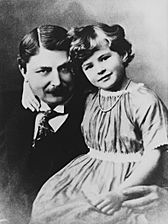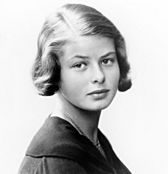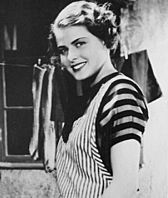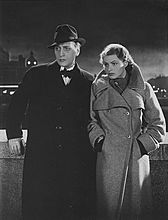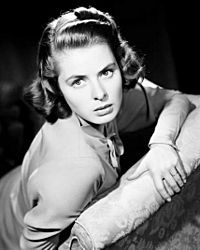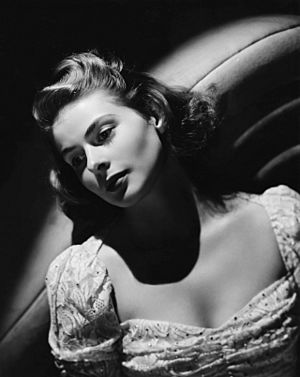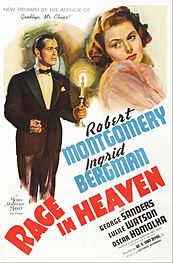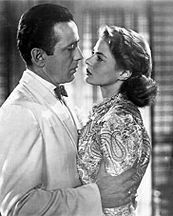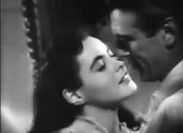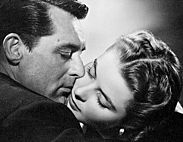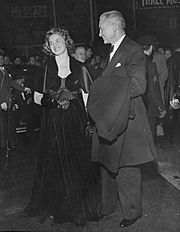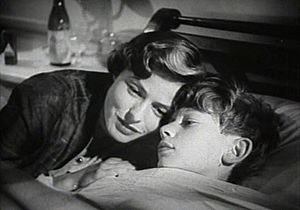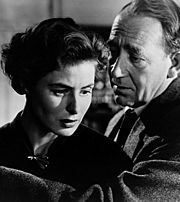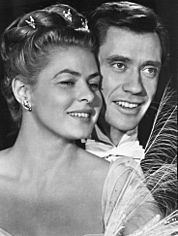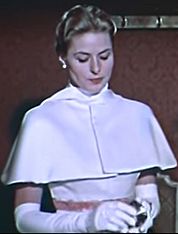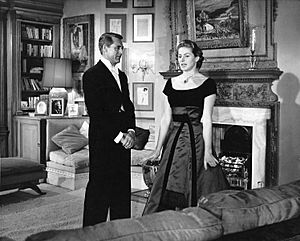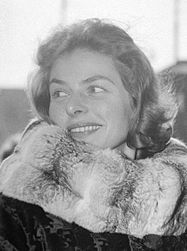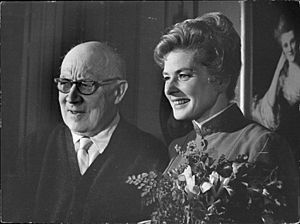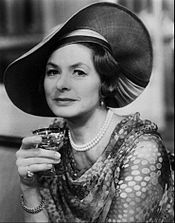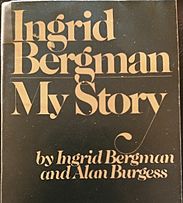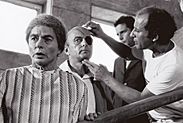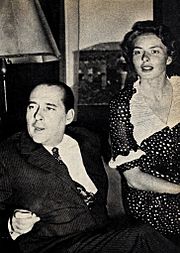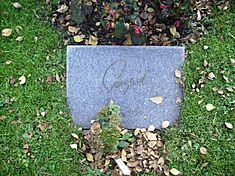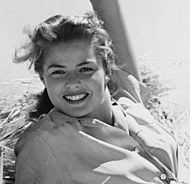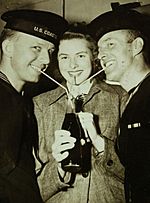Ingrid Bergman facts for kids
Quick facts for kids
Ingrid Bergman
|
|
|---|---|
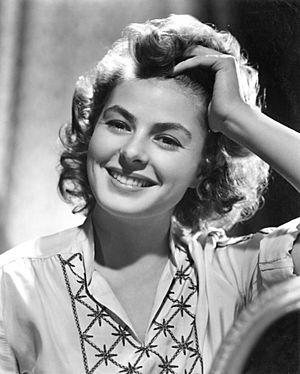
Bergman in 1944
|
|
| Born | 29 August 1915 Stockholm, Sweden
|
| Died | 29 August 1982 (aged 67) London, England
|
| Resting place | Norra Begravningsplatsen, Stockholm |
| Occupation | Actress |
| Years active | 1932–1982 |
|
Notable work
|
|
| Spouse(s) |
Petter Lindström
(m. 1937; div. 1950)Lars Schmidt
(m. 1958; div. 1975) |
| Children | 4, including Pia Lindström and Isabella Rossellini |
| Awards | Full list |
| Signature | |
 |
|
Ingrid Bergman (29 August 1915 – 29 August 1982) was a Swedish actress who starred in a variety of European and American films, television movies, and plays. With a career spanning five decades, she is often regarded as one of the most influential screen figures in cinematic history.
Contents
Early life
Ingrid Bergman was born on 29 August 1915 in Stockholm, to a Swedish father, Justus Samuel Bergman (2 May 1871 – 29 July 1929), and his German wife, Frieda "Friedel" Henriette Auguste Louise (née Adler) Bergman (12 September 1884 – 19 January 1918), who was born in Kiel. Her parents married in Hamburg on 13 June 1907. She was named after Princess Ingrid of Sweden. Although she was raised in Sweden, she spent her summers in Germany and spoke fluent German.
Bergman was raised an only child, as two older siblings had died in infancy before she was born. When she was two and a half years old, her mother died. Justus Bergman had wanted his daughter to become an opera star and had her take voice lessons for three years. He sent her to the Palmgrenska Samskolan, a prestigious girls' school in Stockholm where Bergman was reportedly neither a good student nor popular.
Justus was a photographer, and loved to document his daughter's birthdays with his camera. He made his daughter one of his favorite photographic subjects. She enjoyed dancing, dressing up and acting in front of her father's lenses. "I was perhaps the most photographed child in Scandinavia", quipped Bergman in her later years. In 1929, when Bergman was around 14, her father died of stomach cancer. Losing her parents at such a young age was a trauma that Bergman later described as "living with an ache", an experience she was not even aware of.
After her father's death, Bergman was sent to live with her paternal aunt, Ellen, who died of heart disease six months later. Bergman then lived with her maternal aunt Hulda and her husband Otto, who had five children of their own. She also visited her other maternal aunt, Elsa Adler, whom the young girl called Mutti (Mom) according to family lore. She later said she "knew from the beginning that [she] wanted to be an actress," sometimes wearing her deceased mother's clothing, and staging plays in her father's empty studio.
Bergman spoke Swedish and German as first languages, English and Italian (acquired later, while living in the US and Italy), and French (learned in school). She acted in each of these languages at various times.
Bergman received a scholarship to the state-sponsored Royal Dramatic Theatre School, where Greta Garbo had some years earlier earned a similar scholarship. After several months, she was given a part in a new play, Ett Brott (A Crime), written by Sigfrid Siwertz. This was "totally against procedure" at the school, where girls were expected to complete three years of study before getting such acting roles. During her first summer break, Bergman was hired by a Swedish film studio, which led her to leave the Royal Dramatic Theatre after just one year to work in films full-time.
Career
1935−1938: Swedish years
Bergman's first film experience was as an extra in the 1932 film Landskamp, an experience she described as "walking on holy ground". Her first speaking role was a small part in Munkbrogreven (1934). Bergman played Elsa, a maid in a seedy hotel, being pursued by the leading man, Edvin Adolphson. Critics called her "hefty and sure of herself", and "somewhat overweight ... with an unusual way of speaking her lines". The unflatteringly striped costume that she wore may have contributed to the unfavorable comments regarding her appearance. Soon after, Munkbrogreven, Bergman was offered a studio contract and placed under director Gustaf Molander.
Bergman starred in Ocean Breakers, in which she played a fisherman's daughter, and then in Swedenhielms, where she had the opportunity to work alongside her idol Gösta Ekman. Next, she starred in Walpurgis Night (1935). She played Lena, a secretary in love with her boss, Johan, who is unhappily married. Throughout, Lena and the wife vie for Johan's affection, with the wife losing her husband to Lena at the end.
In 1936, in On the Sunny Side, Bergman was cast as an orphan from a good family who marries a rich older gentleman. Also in 1936, she appeared in Intermezzo, her first lead performance, where she was reunited with Gösta Ekman. This was a pivotal film for the young actress and allowed her to demonstrate her talent. Director Molander later said: "I created Intermezzo for her, but I was not responsible for its success. Ingrid herself made it successful." In 1938, she starred in Only One Night, playing an upper-class woman living on a country estate. She didn't like the part, calling it "a piece of rubbish". She only agreed to appear if only she could star in the studio's next film project, En kvinnas ansikte. She later acted in Dollar (1938), a Scandinivian screwball comedy. Bergman had just been voted Sweden's most admired movie star in the previous year and received top billing. Svenska Dagbladet wrote in its review: "Ingrid Bergman's feline appearance as an industrial tycoon's wife overshadows them all."
In her next film, a role created especially for her, En kvinnas ansikte (A Woman's Face), she played against her usual casting, as a bitter, unsympathetic character, whose face had been hideously burned. Anna Holm is the leader of a blackmail gang that targets the wealthy folk of Stockholm for their money and jewellery. The film required Bergman to wear heavy make-up, as well as glue, to simulate a burned face. A brace was put in place to distort the shape of one cheek. In her diary, she called the film "my own picture, my very own. I have fought for it.". The critics loved her performance, citing her as an actor of great talent and confidence. The film was awarded a Special Recommendation at the 1938 Venice Film Festival, for its "overall artistic contribution". It was remade in 1941 by Metro-Goldwyn-Mayer with the same title, starring Joan Crawford.
Bergman signed a three-picture contract with UFA, the German major film company, although she only made one picture. At the time, she was pregnant, but, nonetheless, she arrived in Berlin to begin filming The Four Companions (Die vier Gesellen) (1938), directed by Carl Froelich. The film was intended as a star vehicle to launch Bergman's career in Germany. In the film, she played one of four ambitious young women, attempting to set up a graphic design agency. The film was a light-hearted combination of comedy and romance. At first, she did not comprehend the political and social situation in Germany. Later, she said: "I saw very quickly that if you were anybody at all in films, you had to be a member of the Nazi party." By September, she was back in Sweden, and gave birth to her daughter, Pia. She was never to work in Germany again.
Bergman appeared in eleven films in her native Sweden before the age of twenty-five. Her characters were always plagued with uncertainty, fear, and anxiety. The early Swedish films were not masterpieces, but she worked with some of the biggest talents in the Swedish film industry, such as Gösta Ekman, Karin Swanström, Victor Sjöström, and Lars Hanson. It showcased her immense acting talent, as a young woman with a bright future ahead of her.
1939−1949: Hollywood and stage work breakthrough
Bergman's first acting role in the United States was in Intermezzo: A Love Story by Gregory Ratoff which premiered on 22 September 1939. She accepted the invitation of Hollywood producer David O. Selznick, who wished her to star in the English-language remake of her earlier Swedish film Intermezzo (1936). Unable to speak English, and uncertain about her acceptance by the American audience, she expected to complete this one film and return home to Sweden. Her husband, Dr Petter Aron Lindström, remained in Sweden with their daughter Pia (born 1938). In Intermezzo, she played the role of a young piano accompanist, opposite Leslie Howard, who played a famous violin virtuoso. Bergman arrived in Los Angeles on 6 May 1939 and stayed at the Selznick home until she could find another residence.
According to Selznick's son Danny, who was a child at the time, his father had concerns about Bergman: "She didn't speak English, she was too tall, her name sounded too German, and her eyebrows were too thick". Bergman was soon accepted without having to modify her looks or name, despite some early suggestions by Selznick. "He let her have her way", notes a story in Life magazine. Selznick understood her fear of Hollywood make-up artists, who might turn her into someone she wouldn't recognize, and "instructed them to lay off". He was also aware that her natural good looks would compete successfully with Hollywood's "synthetic razzle-dazzle". During the following weeks, while Intermezzo was being filmed, Selznick was also filming Gone with the Wind.
Intermezzo became an enormous success and as a result, Bergman became a star. Ratoff, said, "She is sensational." This was the "sentiment of the entire set", wrote a retrospective, adding that workmen went out of their way to do things for her and that the cast and crew "admired the quick, alert concentration she gave to direction and to her lines". Film historian David Thomson notes that this became "the start of an astonishing impact on Hollywood and America", where her lack of make-up contributed to an "air of nobility". According to Life, the impression that she left on Hollywood, after she returned to Sweden, was of a tall girl "with light brown hair and blue eyes who was painfully shy, but friendly, with a warm, straight, quick smile".
Selznick appreciated her uniqueness. Bergman was hailed as a fine new talent, and received many positive reviews. The New York Times noted her "freshness and simplicity and natural dignity" and the maturity of her acting which was nonetheless, free of "stylistic traits - the mannerisms, postures, precise inflections - that become the stock in trade of the matured actress". Variety noted that she was warm and convincing, and provided an "arresting performance" and that her "charm, sincerity" ...and "infectious vivaciousness" would "serve her well in both comedy and drama". There was also recognition of her natural appearance, in contrast to other film actresses. The New York Tribune critic wrote: "Using scarcely any make-up, but playing with mobile intensity, she creates the character so vividly and credibility that it becomes the core of [the] narrative." Bergman made her stage debut in 1940 with Liliom opposite Burgess Meredith, at a time when she was still learning English. Selznick was worried that his new starlet's value would diminish if she received bad reviews. Brooks Atkinson of The New York Times reviewed that Bergman seemed at ease, and commanded the stage that evening. That same year she starred in June Night (Juninatten), a Swedish language drama film directed by Per Lindberg. She plays Kerstin, a woman who has been shot by her lover. The news reaches the national papers. Kerstin moves to Stockholm under the new name of Sara, but lives under the scrutiny and watchful eye of her new community. Öresunds-Posten wrote, "Bergman establishes herself as an actress belonging to the world elite."
Bergman was loaned out of David O. Selznick's company, to appear in three films which were released in 1941. On 18 February, Robert Sherwood Productions' released her second collaboration with Gregory Ratoff, Adam Had Four Sons. On 7 March, Metro-Goldwyn-Mayer released W. S. Van Dyke's Rage in Heaven.
On 30 July 1941 at the Lobero Theatre in Santa Barbara, Bergman made her second stage appearance in Anna Christie. She was praised for her performance in the play based on Eugene O'Neill's work.
Casablanca, by Michael Curtiz, opened on 26 November 1942. Bergman co-starred with Humphrey Bogart in the film; this remains her best-known role. She played the role of Ilsa, the former love of Rick Blaine and wife of Victor Laszlo, fleeing with Laszlo to the United States. The film premiered on 26 November 1942 at New York's Hollywood Theater. The Hollywood Reporter wrote, "The events are shot with sharp humor and delightful touches of political satire." It went into more general release, in January 1943.Casablanca was not one of Bergman's favorite performances. "I made so many films which were more important, but the only one people ever want to talk about is that one with Bogart." In later years, she stated, "I feel about Casablanca that it has a life of its own. There is something mystical about it. It seems to have filled a need, a need that was there before the film, a need that the film filled". Despite her personal views regarding her performance, Bosley Crowther of The New York Times wrote that "... Bergman was surprisingly lovely, crisp and natural...and lights the romantic passages with a warm and genuine glow". Other reviewers said that she "[plays] the heroine with...appealing authority and beauty" and "illuminates every scene in which she appears" and compared her to "a youthful Garbo."
For Whom the Bell Tolls had its New York premiere on 14 July 1943. With "Selznick's steady boosting", she played the part of Maria, it was also her first color film. For the role, she received her first Academy Award nomination for Best Actress. The film was adapted from Ernest Hemingway's novel of the same title and co-starred Gary Cooper. When the book was sold to Paramount Pictures, Hemingway stated that "Miss Bergman, and no one else, should play the part". His opinion came from seeing her in her first American role, Intermezzo. They met a few weeks later, and after studying her, he declared, "You are Maria!".
Gaslight opened on 4 May 1944. Bergman won her first Academy Award for Best Actress for her performance. Under the direction of George Cukor, she portrayed a "wife driven close to madness" by her husband, played by Charles Boyer. The film, according to Thomson, "was the peak of her Hollywood glory." Reviewers noted her sympathetic and emotional performance, and that she exercised restraint, by not allowing emotion to "slip off into hysteria". The New York Journal-American called her "one of the finest actresses in filmdom" and said that "she flames in passion and flickers in depression until the audience - becomes rigid in its seats".
The Bells of St. Mary's premiered on 6 December 1945. Bergman played a nun opposite Bing Crosby, for which she received her third consecutive nomination for Best Actress. Crosby plays a priest who is assigned to a Roman Catholic school where he conflicts with its headmistress, played by Bergman. Reviewer Nathan Robin said: 'Crosby's laconic ease brings out the impishness behind Bergman's fine-china delicacy, and Bergman proves a surprisingly spunky and spirited comic foil for Crosby'. The film was the biggest box office hit of 1945.
Alfred Hitchcock's Spellbound premiered on 28 December 1945. In Spellbound, Bergman played Dr. Constance Petersen, a psychiatrist whose analysis could determine whether or not Dr. Anthony Edwardes, played by Gregory Peck, is guilty of murder. Artist Salvador Dalí was hired to create a dream sequences but much of what had been shot was cut by Selznick. During the film, she had the opportunity to appear with Michael Chekhov, who was her acting coach during the 1940s. This would be the first of three collaborations she had with Hitchcock.
Next, Bergman starred in Saratoga Trunk, with Gary Cooper, a film originally shot in 1943, but released on 30 March 1946. It was first released to the armed forces overseas. In deference to more timely war-themed and patriotic films, Warner Bros held back the theatrical opening in the United States. On 6 September premiered Hitchcock's Notorious. In it, Bergman played a US spy, Alicia Huberman, who had been given an assignment to infiltrate the Nazi sympathizers in South America. Along the way, she fell in love with her fellow spy, played by Cary Grant. The film also starred Claude Rains in an Oscar-nominated performance by a supporting actor. According to Roger Ebert, Notorious is the most elegant expression of Hitchcock's visual style. "Notorious is my favorite Hitchcock", he asserted. Writing for the BFI, Samuel Wigley called it a "perfect" film. Notorious was selected by the National Film Registry in 2006 as culturally and significantly important.
On 5 October 1946, Bergman appeared in Joan of Lorraine at the Alvin Theatre in New York. Tickets were fully booked for a twelve-week run. It was the greatest hit in New York. After each performance, crowds were in line to see Bergman in person. Newsweek called her 'Queen of the Broadway Season.' She reportedly received roughly $129,000 plus 15 percent of the grosses. The Associated Press named her "Woman of the Year". Gallup certified her as the most popular actress in America.
On 17 February 1948, Arch of Triumph, by Lewis Milestone was released with Bergman and Charles Boyer as the leading roles based on Erich Maria Remarque's book. On 11 November 1948, Joan of Arc had its world premiere. For her role, Bergman received another Best Actress nomination. The independent film was based on the Maxwell Anderson play Joan of Lorraine, which had earned her a Tony Award earlier that year. Produced by Walter Wanger and initially released through RKO. Bergman had championed the role since her arrival in Hollywood, then chose to appear on the Broadway stage in Anderson's play. The film was not a big hit with the public, partly because of the Rossellini scandal, which broke while the film was still in theatres. Even worse, it received disastrous reviews, and, although nominated for several Academy Awards, did not receive a Best Picture nomination. It was subsequently cut by 45 minutes, but restored to full length in 1998, and released in 2004 on DVD.
Under Capricorn premiered on 9 September 1949, as another Bergman and Hitchcock collaboration. The film is set in the Australia of 1831. The film met with negative reactions from critics.
1950−1955: Italian films with Rossellini
Stromboli was released by Italian director Roberto Rossellini on 18 February 1950. Bergman had greatly admired two films by Rossellini. She wrote to him in 1949, expressing her admiration and suggesting that she make a film with him. As a consequence, she was cast in Stromboli. In the United States, the film was a box office bomb but did better overseas. In Italy, it was awarded the Rome Prize for Cinema as the best film of the year.
The initial reception in America, however, was very negative.
Recent assessments have been more positive. The Venice Film Festival ranked Stromboli among the 100 most important Italian films ("100 film italiani da salvare") from 1942 to 1978. In 2012, the British Film Institute's Sight & Sound critics' poll also listed it as one of the 250 greatest films of all time.
During the production, Bergman and Rossellini became romantically involved and were married on 24 May 1950.
In 1952, Rossellini directed Bergman in Europa '51, where she plays Irene Girard who is distraught by the sudden death of her son. Her husband played by Alexander Knox soon copes, but Irene seems to need a purpose in life to assuage her guilt of neglecting her son.
Rossellini directed her in a brief segment of his 1953 documentary film, Siamo donne (We, the Women), which was devoted to film actresses. In December 1953, Rossellini directed her in the play Joan of Arc at the Stake in Naples, Italy. They took the play to Barcelona, London, Paris and Stockholm. Her performance received generally good reviews.
Their following effort was Viaggio in Italia (Journey to Italy) in 1954. It follows a couple's journey to Naples, Italy to sell off an inherited house. Trapped in a lifeless marriage, they are further unnerved by the locals' way of living. According to John Patterson of The Guardian, the film started The French New Wave. Martin Scorsese picked this film to be among his favorites in his documentary short in 2001. On 17 February 1955, Joan at the Stake opened at the Stockholm Opera House. The play was attended by the prime minister and other theatrical figures in Sweden. Swedish Daily reported that Bergman seems vague, cool and lacking in charisma. Bergman was hurt by mostly negative reviews from the media of her native land. Stig Ahlgren was the most harsh when he labelled her a clever businesswoman, not an actress. "Ingrid is a commodity, a desirable commodity which is offered in the free market." Another effort they released that year was Giovanna d'Arco al rogo.
Their final effort in 1955 was La Paura (Fear), based on a play by Austro-Jewish writer Stefan Zweig's 1920 novella Angst.
Rossellini's use of a Hollywood star in his typically "neorealist" films, in which he normally used non-professional actors, provoked some negative reactions in certain circles.
While the movies Bergman made with Rossellini were commercial failures, the films have garnered great appreciation and attention in recent times. According to Jordan Cronk in his article reviewing the movies, their work has inspired a beginning of a modern cinematic era. Rossellini's films during the Bergman era ponder issues of complex psychology as depicted by Bergman in films like Stromboli, Europa '51 and Journey to Italy. The influence of Bergman and Rossellini's partnership can be felt in the movies by Godard, Fellini and Antonioni to more recently, Abbas Kiarostami and Nuri Bilge Ceylan. David Kehr from The New York Times commented that their works now stand as one of the pioneering works whose influence can be felt in European modern filmmaking.
1956−1972: Hollywood return
After separating from Rossellini, Bergman starred in Jean Renoir's Elena and Her Men (Elena et les Hommes, 1956), a romantic comedy in which she played a Polish princess caught up in political intrigue. Bergman and Renoir had been wanting to work together. In Elena and Her Men, which Renoir had written for her, she plays a down-on-her-luck Polish princess, Elena Sorokowska. The film was a hit in Paris when it premiered in September 1956. Candice Russell, commented that Bergman is the best thing in the film.
In 1956, Bergman also starred in a French adaptation of stage production of Tea and Sympathy. It was presented at the Théâtre de Paris, Paris.
Twentieth Century Fox had bought the rights to Anastasia with Anatole Litvak slated to direct. Filming was going to be made in England, Paris, and Copenhagen.
Anastasia (1956) tells the story of a woman who may be the sole surviving member of the Romanov family. Yul Brynner is the scheming general, who tries to pass her off as the single surviving daughter of the late Tsar Nicholas II. He hopes to use her to collect a hefty inheritance. Anastasia was an immediate success. Bosley Crowther wrote in the New York Times, "It is a beautifully molded performance, worthy of an Academy Award and particularly gratifying in the light of Miss Bergman's long absence from commendable films."
With her role in Anastasia, Bergman made a triumphant return to working for a Hollywood studio (albeit in a film produced in Europe) and won the Academy Award for Best Actress for a second time. Cary Grant accepted the award on her behalf.
After Anastasia, Bergman starred in Indiscreet (1958), a romantic comedy directed by Stanley Donen. She plays a successful London stage actress, Anna Kalman, who falls in love with Philip Adams, a diplomat played by Cary Grant. The film is based on the play 'Kind Sir' written by Norman Krasna. Although unmarried, he tells her that he is married but cannot get a divorce. He does so, in order to remain single. Cecil Parker and Phyllis Calvert also co-starred.
Bergman later starred in the 1958 picture The Inn of the Sixth Happiness, based on a true story about Gladys Aylward, a Christian missionary in China who, despite many obstacles, was able to win the hearts of the natives through patience and sincerity. In the film's climactic scene, she leads a group of orphaned children to safety, to escape from the Japanese invasion. The New York Times wrote, "the justification of her achievements is revealed by no other displays than those of Miss Bergman's mellow beauty, friendly manner and melting charm." The film also co-starred Robert Donat and Curd Jurgens.
Bergman made an appearance in Hollywood at the 30th Academy Awards in 1959, as presenter of the award for Best Picture, and received a standing ovation when introduced. Bergman made her television debut in an episode of Startime, an anthology show, which presented dramas, musical comedies, and variety shows., The episode presented The Turn of the Screw, an adaptation of the horror novella by Henry James and directed by John Frankenheimer. She played a governess to two little children, who are haunted by the ghost of their previous caretaker. For this performance, she was awarded the 1960 Emmy for best dramatic performance by an actress. Also in 1960, Bergman was inducted into the Hollywood Walk of Fame with a motion pictures star at 6759 Hollywood Boulevard.
In 1961, Bergman's second American television production, Twenty-four Hours in a Woman's Life, was produced by her third husband, Lars Schmidt. Bergman played a bereaved wife, in love with a younger man she has known for only 24 hours. She later starred in Goodbye Again as Paula Tessier, a middle-aged interior decorator who falls in love with Anthony Perkins' character, who is fifteen years her junior. Paula is in relationship with Roger Demarest, a womanizer, played by Yves Montand. Roger loves Paula but reluctant to give up his womanizing ways. When Perkins starts pursuing her, the lonely Paula is suddenly forced to choose between the two men. In his review of the film, Bosley Crowther wrote that Bergman was neither convincing nor interesting in her part as Perkins's lover.
In 1962, Schmidt also co-produced his wife's third venture into American television, Hedda Gabler, made for BBC and CBS. She played the titular character opposite Michael Redgrave and Ralph Richardson. David Duprey wrote in his review, "Bergman and Sir Ralph Richardson on screen at the same time is like peanut butter and chocolate spread on warm toast." Later in the year, she took the titular role of Hedda Gabler in Paris's Theatre Montparnasse.
On 23 September 1964, The Visit premiered. Based on Friedrich Dürrenmatt's 1956 play, Der Besuch der alten Dame; eine tragische Komödie, it starred Bergman and Anthony Quinn. With a production budget of $1.5 million, principal photography took place in Capranica, outside of Rome. She plays Karla Zachanassian, the world's richest woman, who returns to her birthplace, seeking revenge.
On 13 May 1965, Anthony Asquith's The Yellow Rolls-Royce premiered. Bergman plays Gerda Millett, a wealthy American widow who meets up with a Yugoslavian partisan, Omar Sharif. For her role, she was reportedly paid $250,000. That same year, although known chiefly as a film star, Bergman appeared in London's West End, working with stage star Michael Redgrave in A Month in the Country. She took on the role of Natalia Petrovna, a lovely headstrong woman, bored with her marriage and her life. According to The Times, "The production would hardly have exerted this special appeal without the presence of Ingrid Bergman."
In 1966, Bergman acted in only one project, an hour-long television version of Jean Cocteau's one-character play, The Human Voice. It tells a story of a lonely woman in her apartment talking on the phone to her lover who is about to leave her for another woman. The New York Times praised her performance, calling it a tour-de-force. The Times of London echoed the same sentiment, describing it as a great dramatic performance through this harrowing monologue.
In 1967, Bergman was cast in a short episode of Swedish anthology film, Stimulantia. Her segment which is based on the Guy de Maupassant's The Jewellery reunited her with Gustaf Molander. Next, Eugene O'Neill's More Stately Mansions directed by José Quintero, opened on 26 October 1967. Bergman, Colleen Dewhurst, and Arthur Hill appeared in the leading roles. The show closed on 2 March 1968 after 142 performances. It was reported that thousand of spectators bought tickets, and travelled across the country, to see Bergman perform. Bergman returned as both a presenter and a performer during the 41st Annual Academy Awards in 1969.
Bergman wished to work in American films again, following a long hiatus. She starred in Cactus Flower released in 1969, with Walter Matthau and Goldie Hawn. On 9 April 1970, Guy Green's A Walk in the Spring Rain had its world premiere. The screenplay was based on the romantic novel written by Rachel Maddux.
On 18 February 1971, Captain Brassbound's Conversion, a play based on George Bernard Shaw's work, made a debut at London theatre. She took on the role of a woman whose husband has taken up with a woman half her age. Although the play was a commercial success, critics were not very receptive of Bergman's British accent.
1973−1982: Later years and continued success
On 27 September 1972, Fielder Cook's From the Mixed-Up Files of Mrs. Basil E. Frankweiler premiered. She plays the titular character, a wealthy recluse who befriends two children who are seeking "treasure" in the Metropolitan Museum of Art .
Also that year, Bergman was the president of the jury at the 1973 Cannes Film Festival. In an interview with The Daytona Beach Sunday News in 1978, she recalled this event because she met with Ingmar Bergman once again. This gave her the opportunity to remind him about the letter she had written, some ten years ago, asking him to cast her in one of his pictures. Knowing that Ingmar would be attending, she made a copy of his long-ago reply, and put it in his pocket. He didn't reply again, for two years.
Next, Bergman returned to London's West End and appeared with John Gielgud in The Constant Wife, which was a critical success. The theatre was consistently packed. The Daily Telegraph found the play "unusually entertaining", while Harold Hobson of The Sunday Times was still peeved at Bergman for playing yet another English woman with a "strange accent".
Bergman became one of the few actresses ever to receive three Oscars when she won her third (and first in the category of Best Supporting Actress) for her performance in Murder on the Orient Express (1974). Director Sidney Lumet had offered Bergman the important part of Princess Dragomiroff, with which he felt she could win an Oscar. She insisted on playing the much smaller role of Greta Ohlsson, the old Swedish missionary.
At the 1975 Academy Awards, film director Jean Renoir was to receive a Lifetime Achievement Award for his contribution to the motion picture industry. As he was ill at the time, he asked that Ingrid Bergman accept this award on his behalf. Bergman made a speech of acceptance that praised his films and the "compassion that marked all his works" as well as his teaching of both young filmmakers and audiences. Although she had been nominated for the new Best Supporting Actress Award, she considered her role in Murder on the Orient Express to be quite minor and did not expect to win. When the award was announced, in her surprised and unrehearsed remarks, she remarked to the audience that Valentina Cortese should have won the award for her role in Day for Night, by Truffaut. Bergman and Cortese spent the rest of the evening in each other's company, and were the subject of many photographs. Also in 1975, Bergman attended the AFI tribute to Orson Welles. The audience gave her a standing ovation when she appeared on stage. She joked that she hardly knew Welles and they only invited her because she was working across the street.
In 1976, Bergman was the first person to receive France's newly created Honorary César, a national film award. She also appeared in A Matter of Time, by Vincente Minnelli, which premiered on 7 October 1976. Roger Ebert in his review wrote, ""A Matter of Time" is a fairly large disappointment as a movie, but as an occasion for reverie, it does very nicely. Once we've finally given up on the plot - a meandering and jumbled business - we're left with the opportunity to contemplate Ingrid Bergman at 60. And to contemplate Ingrid Bergman at any age is, I submit, a passable way to spend one's time."
From 1977 to 1978, Bergman returned to the London's West with Wendy Hiller in Waters of the Moon. She played Helen Lancaster, a rich, self-centred woman whose car becomes stuck in a snowdrift. The play became the great new hit of the season.
In 1978, Bergman appeared in Autumn Sonata (Höstsonaten), by accomplished Swedish filmmaker, Ingmar Bergman (no relation), for which she received her seventh — and final — Academy Award nomination. She did not attend the awards, due to her illness. This was her final cinema performance. The film gave her the opportunity to work with Liv Ullmann, another well-known and respected Scandinavian artist. In the film, Bergman plays a celebrity pianist, Charlotte, who travels to Norway intending to visit her neglected eldest daughter, Eva, played by Ullmann. Eva is married to a clergyman and they care for her sister, Helena, who is severely disabled, paralyzed, and unable to speak clearly. Charlotte has not visited either of her two daughters for seven years. Upon arrival at Eva's home, she is shocked and dismayed to learn that her younger daughter is also in residence, and not still in the institution "home". Very late that night, Eva and Charlotte have an impassioned and painful conversation about their past relationship. Charlotte leaves the next day. The film was shot in Norway.
Bergman was battling cancer at the time of the filming. The final two weeks of the shooting schedule required adjustment because she required additional surgery. Believing that her career was nearing its end, Bergman wanted her swan song to be honourable. She was pleased with the overwhelming critical acclaim for Autumn Sonata. Stanley Kaufmann of The New Republic wrote, "The astonishment is Bergman's performance. We've all adored her for decades but not many of us have thought her a superb actress. Here, she exalted in the hands of a master." Newsweek wrote, "An expressive force we can't even remember seeing since Hollywood grabbed her." The Times (London) concurred that it was "a tour-de-force, such as the cinema rarely sees". Both Bergman and Ullmann won the New York Film Critic's Award and Italy's Donatello award, for their roles. Bergman later recalled that Ingmar had possibly given her the best role of her career, that she would never make another movie again. "I don't want to go down and play little parts. This should be the end."
In 1979, Bergman hosted the AFI's Life Achievement Award Ceremony for Alfred Hitchcock. At the program's finale, she presented him with the wine cellar key that was crucial to the plot of Notorious. "Cary Grant kept this for 10 years, then he gave it to me, and I kept it for 20 years for good luck and now I give it to you with my prayers," before adding "God bless you, Hitch." Bergman was the guest of honour in the Variety's Club All Star Salute program in December 1979. The show was hosted by Jimmy Stewart and was attended by Cary Grant, Frank Sinatra, Goldie Hawn, Helen Hayes, Paul Henreid and many of her former co-stars. She was honored with the Illis Quorum, the medal given to artists of significance by the King of Sweden.
In the late '70s, Bergman appeared on several talk shows and was interviewed by Merv Griffin, David Frost, Michael Parkinson, Mike Douglas, John Russell and Dick Cavett, discussing her life and career.
In 1980, Bergman's autobiography, Ingrid Bergman: My Story, was written with the help of Alan Burgess. In it, she discusses her childhood, her early career, her life during her time in Hollywood, the Rossellini scandal, and subsequent events. The book was written after her son warned her that she would only be known through rumors and interviews if she did not tell her own story. In 1982, she was awarded the David di Donatello's Golden Medal of the Minister of Tourism, given by The Academy of Italian Cinema.
Finally that year, Bergman played the starring role in a television mini-series, A Woman Called Golda (1982), about the late Israeli prime minister Golda Meir. It was to be her final acting role and she was honored posthumously with a second Emmy Award for Best Actress. Bergman was surprised to be offered the role, but the producer explained, "People believe you and trust you, and this is what I want, because Golda Meir had the trust of the people." Her daughter Isabella added, "Now, that was interesting to Mother." She was also persuaded that Golda was a "grand-scale person", one that people would assume was much taller than she actually was. Chandler notes that the role "also had a special significance for her, as during World War II, Ingrid felt guilty because she had so misjudged the situation in Germany".
According to Chandler, "Ingrid's rapidly deteriorating health was a more serious problem. Insurance for Bergman was impossible. Not only did she have cancer, but it was spreading, and if anyone had known how bad it was, no one would have gone on with the project."
Her daughter said that Bergman identified with Golda Meir, because she, too had felt guilty. Bergman tried to strike a balance between home and work responsibilities and deal with "the inability to be in two places at one time". Bergman's arm was terribly swollen from her cancer surgery. She was often ill during the filming, recovering from the mastectomy and the removal of lymph nodes. It was important to her, as an actress, to make a certain gesture of Meir's, which required her to raise both arms, but she was unable to properly raise one arm. During the night, her arm was propped up, in an uncomfortable position, so that the fluid would drain, and enable her to perform her character's important gesture.
Despite her health problems, she rarely complained or let others see the difficulties she endured. Four months after the filming was completed, Bergman passed away on her 67th birthday. After her death, her daughter Pia accepted her Emmy.
Personal life
Marriages and children
On 10 July 1937, at the age of 21, in Stöde, Bergman married a dentist, Petter Aron Lindström (1 March 1907 – 24 May 2000), who later became a neurosurgeon. The couple had one child, a daughter, Friedel Pia Lindström (born 20 September 1938).
Bergman divorced Lindström in 1950 to marry Rossellini. The couple had 3 children: a boy, Renato Roberto Ranaldo Giusto Giuseppe ("Robin") Rossellini (born 2 February 1950), and twin daughters Isotta Ingrid Rossellini and Isabella Rossellini. Isabella became an actress and model, and Isotta Ingrid became a professor of Italian literature.
Her marriage with Rossellini experienced several problems and eventually ended in divorce in 1957.
On 21 December 1958, Bergman married Lars Schmidt, a theatrical entrepreneur from a wealthy Swedish shipping family. After almost two decades of marriage, the couple divorced in 1975. Nonetheless, he was by her side when she died on 29 August 1982, her 67th birthday.
Before her death in 1982, Bergman made a few alterations in her will. The bulk of her estate was divided among her four children. She left some provisions for Rossellini's niece, Fiorella, her maid in Rome, and her agent's daughter, Kate Brown.
Illness and death
During the run of The Constant Wife in London, Bergman was diagnosed with breast cancer. Despite her illness, she agreed to play Golda Meir in 1981. Bergman retired to her apartment in Cheyne Gardens, London after the film had finished where she underwent chemotherapy. Photographers had camped outside on the pavement of her London apartment. As the cameras had telephoto lenses, Bergman refrained from approaching the front window. At this point, the cancer had spread to her spine, collapsing her twelfth vertebra. Her right lung no longer functioned, and only a small part of her left lung had not collapsed.
On 29 August 1982 at midnight on her 67th birthday, Bergman died in London. Her ex-husband, Lars Schmidt, and three others were there, where they drank their last toast to her hours earlier. A copy of The Little Prince was at her bedside, opened to a page near the end. The memorial service was held in Saint Martin-in-the-Fields church in October with twelve hundred mourners in attendance. Her children were in attendance. In addition to the Rossellinis and relatives from Sweden, numerous fellow actors and costars, including Liv Ullmann, Sir John Gielgud, Dame Wendy Hiller, Birgit Nilsson, Joss Ackland, attended. As part of the service, quotations from Shakespeare were read. Musical selections included "This Old Man" from The Inn of the Sixth Happiness, a piece by Beethoven, and strains of "As Time Goes By". Bergman's grandson, Justin Daly, recalled the event as hundreds of photographers were waiting and taking pictures. One of their cameras hit him on the head. He added, "In the middle of all this chaos, I could sense that she wasn't just my grandmother. She belonged to everyone else. She belonged to the world."
Ingrid Bergman was cremated at a private funeral ceremony attended only by close relatives and five friends. After cremation at Kensal Green Cemetery (London), her ashes were taken to Sweden.
Most were scattered into the sea, around the islet of Dannholmen near the fishing village of Fjällbacka in Bohuslän. The location is on the west coast of Sweden, a place where she had spent most of the summers from 1958 until her death. The remainder of her ashes were placed next to her parents' ashes in Norra Begravningsplatsen (Northern Cemetery), Stockholm, Sweden.
Legacy
The news of Bergman's death was widely reported by mainstream media across the United States and Europe. Both the Los Angeles Times and the New York Post printed front page notices. The New York Post announcement was in bold red. The New York Times stated: "Ingrid Bergman, Winner of Three Oscars Is Dead." The Washington Post paid its tribute in an article that called her "an actress whose innocent yet provocative beauty made her one of the great stars of stage and screen".
Bergman was mourned by many, especially her fellow co-stars. They praised her tenacity, spirit, and warmth. Joseph Cotten considered her a great friend and a great actress. Paul Henreid commented, "She was so terribly beautiful in her youth. She was a very strong lady with great desires and emotions and she led a colorful life." Liv Ullmann said that she would mourn her because "She made me very proud to be a woman," she added. Leonard Nimoy praised her tenacity and courage. "I developed enormous respect for her as a person and talent. She was a marvelous lady and actress".
On 30 August 1983, stars, friends and family came to Venice Film Festival to honour the late Bergman on the first anniversary of her death. Among the many guests were Gregory Peck, Walter Matthau, Audrey Hepburn, Roger Moore, Charlton Heston, Prince Albert of Monaco, Claudette Colbert and Olivia de Havilland. They dined, and wined for five days while remembering Bergman and the legacy she left behind.
Despite suffering from cancer for eight years, Bergman continued her career and won international honours for her final roles. "Her spirit triumphed with remarkable grace and courage", added biographer Donald Spoto. Director George Cukor once summed up her contributions to the film media when he said to her, "Do you know what I especially love about you, Ingrid, my dear? I can sum it up as your naturalness. The camera loves your beauty, your acting, and your individuality. A star must have individuality. It makes you a great star."
Writing about her first years in Hollywood, Life stated that "All Bergman vehicles are blessed", and "they all go speedily and happily, with no temperament from the leading lady". She was "completely pleased" with her early career's management by David O. Selznick, who always found excellent dramatic roles for her to play, and equally satisfied with her salary, once saying, "I am an actress, and I am interested in acting, not in making money." Life adds that "she has greater versatility than any actress on the American screen ... Her roles have demanded an adaptability and sensitiveness of characterization to which few actresses could rise".
Biographer Donald Spoto said she was "arguably the most international star in the history of entertainment". After her American film debut in the film Intermezzo: A Love Story (1939), Hollywood saw her as a unique actress who was completely natural in style, and without need for make-up. Film critic James Agee wrote that she "not only bears a startling resemblance to an imaginable human being; she really knows how to act, in a blend of poetic grace with quiet realism".
According to her daughter, Isabella Rossellini, her mother had a deep sense of freedom and independence. She then added, "She was able to integrate so many cultures... she is not even American but she is totally part of American culture like she is totally part of the Swedish, Italian, French, European film making."
Wesleyan University hosts the "Ingrid Bergman Collection" of Bergman's personal papers, scripts, awards, portraits, photos, scrapbooks, costumes, legal papers, financial records, stills, clippings and memorabilia.
Activism
During a press conference in Washington, D.C. for the promotion of the play Joan of Lorraine, she protested to the newspapers regarding racial segregation after seeing it first hand at Lisner Auditorium, the theater where she was working. This led to significant publicity and some hate mail. A bust of Bergman has been placed outside the Lisner Auditorium, in recognition of her protest, and as a reminder of the venue's segregated past.
Bergman went to Alaska during World War II to entertain US Army troops. Soon after the war ended, she also went to Europe for the same purpose, where she was able to see the devastation caused by the war. She arrived in Paris on 6 June 1945 with Jack Benny, Larry Adler and Martha Tilton where they stayed at The Ritz Hotel. Bergman's performance was rather limited; she couldn't sing, she couldn't play an instrument, she didn't have the humour of Jack Benny. In Kassel, she ran offstage in tears. When they went to see a concentration camp, she stayed behind. After the onset of World War II, Bergman felt guilt for her initial dismissal of the Nazi state in Germany. According to her biographer Charlotte Chandler, she had at first considered the Nazis only a "temporary aberration, 'too foolish to be taken seriously'. She believed Germany would not start a war." Bergman felt that "the good people there would not permit it". Chandler adds that she "felt guilty all the rest of her life because when she was in Germany at the end of the war, she had been afraid to go with others to witness the atrocities of the Nazi extermination camps".
Filmography, theatre, television, radio, and audio
Awards and nominations
Ingrid Bergman became the second actress to win three Academy Awards for acting: two for Best Actress, and one for Best Supporting Actress. She is tied for second place in Oscars won with Walter Brennan (all three for Best Supporting Actor), Jack Nicholson (two for Best Actor, and one for Best Supporting Actor), Meryl Streep (two for Best Actress, and one for Best Supporting Actress), Frances McDormand (all three for Best Actress), and Daniel Day-Lewis (all three for Best Actor). Katharine Hepburn holds the record, with four (all for Best Actress).
In 1960, Bergman became the second actress to complete the American Triple Crown of Acting status, after winning an Emmy Award.
Academy Awards
| Year | Category | Nominated work | Result | Ref. |
|---|---|---|---|---|
| 1943 | Best Actress | For Whom the Bell Tolls | Nominated | |
| 1944 | Gaslight | Won | ||
| 1945 | The Bells of St. Mary's | Nominated | ||
| 1948 | Joan of Arc | Nominated | ||
| 1956 | Anastasia | Won | ||
| 1974 | Best Supporting Actress | Murder on the Orient Express | Won | |
| 1978 | Best Actress | Autumn Sonata | Nominated |
Primetime Emmy Awards
| Year | Category | Nominated work | Result | Ref. |
|---|---|---|---|---|
| 1960 | Outstanding Actress in a Limited Series or TV Movie | The Turn of the Screw | Won | |
| 1961 | 24 Hours in a Woman's Life | Nominated | ||
| 1982 | A Woman Called Golda | Won |
Tony Awards
| Year | Category | Nominated work | Result | Ref. |
|---|---|---|---|---|
| 1947 | Best Leading Actress in a Play | Joan of Lorraine | Won |
See also
 In Spanish: Ingrid Bergman para niños
In Spanish: Ingrid Bergman para niños
- List of actors with two or more Academy Awards in acting categories
- List of Academy Award records – first Nordic to win for acting, in Gaslight (1944)
- List of actors nominated for Academy Awards for non-English performances – nominated for Best Actress, in Autumn Sonata (1978)
- Primetime Emmy Award for Outstanding Lead Actress in a Limited or Anthology Series or Movie
- Tony Award for Best Actress in a Play
Images for kids
-
Ingrid Bergman and Cary Grant had a close friendship, and he accepted her Academy Award on her behalf for her role in Anastasia at the 29th Academy Awards ceremony.


